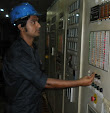Thermocouple Circuits
In the past, thermocouples were often used with a cold junction immersed into a reference melting ice bath to maintain its temperature at 0◦C (thus, the “cold” junction name). This presents serious limitations for many practical uses. The second and third thermoelectric laws allow for a simplified solution. A “cold” junction can be maintained at any temperature, including ambient, as long as that temperature is precisely known. Therefore, a “cold” junction is thermally coupled to an additional temperature sensor which does not require reference compensation. Usually, such a sensor is either thermo resistive or a semiconductor. Figure 16.16B shows the correct connection of a thermocouple to an electronic circuit. Both the “cold” junction and the reference sensor must be positioned in an intimate thermal coupling. Usually, they are imbedded in a chunk of copper. To avoid dry contact, thermally conductive grease or epoxy should be applied for better
Thermal tracking. A reference temperature detector in this example is a semiconductor sensor LM35DZ manufactured by National Semiconductor, Inc. The circuit has two outputs: one for the signal representing the Seebeck voltage Vp and the other for the reference signal Vr . The schematic illustrates that connections to the circuit board input terminals and then to the amplifier’s noninverting input and to the ground bus are made by the same type of wire (Cu). Both board terminals should be at the same temperature Tc; however, they do not necessarily have to be at the “cold” junction temperature. This is especially important for the remote measurements, where the circuit board temperature may be different from the reference “cold” junction temperature Tr . For computing the temperature from a thermocouple sensor, two signals are essentially required.
Δ =Tx −Tr = Vp/αp









